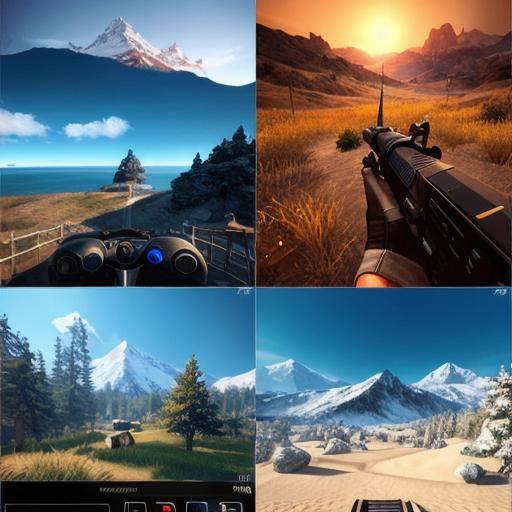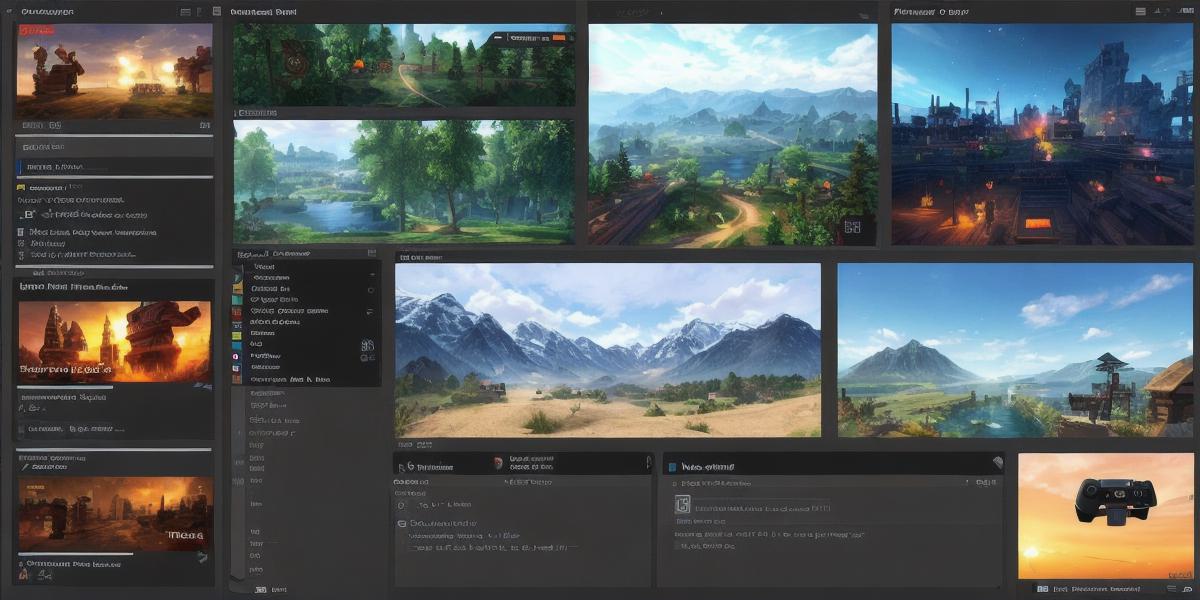Are you looking to create your first video game? Do you want to develop a simple mobile app or a complex console game? Regardless of your experience level, there are plenty of tools available to help you bring your ideas to life. In this article, we will explore the best video game development tools for beginners and provide a comprehensive guide on how to use them effectively.

Why Choose Video Game Development Tools?
Before we dive into the list of tools, let’s first discuss why you should even consider using video game development tools in the first place. Creating a game from scratch can be a daunting task that requires knowledge of programming languages, game engines, and other technical skills. However, with the right tools, you can significantly simplify the process and create your game more efficiently.
Here are some of the benefits of using video game development tools:
- Time-saving: Video game development tools can save you a significant amount of time by automating repetitive tasks and providing pre-built assets that you can use in your game.
- Improved productivity: By streamlining the development process, you can focus on creating the content and features that make your game unique and engaging.
- Reduced costs: Video game development tools are often free or have a low cost, making them accessible to beginners with limited budgets.
- Enhanced collaboration: Many video game development tools allow you to collaborate with others on the project, which can be especially helpful for beginners who may not have the necessary skills or experience to create a game on their own.
The Best Video Game Development Tools for Beginners
Now that we’ve discussed why video game development tools are important let’s take a look at some of the best options available to beginners.
- Unity
Unity is one of the most popular game engines on the market, and for good reason. It offers a wide range of features and tools that make it easy to create games for multiple platforms, including desktop, mobile, console, and VR.
Some of the key features of Unity include:
- A built-in scripting language that allows you to write custom code in C or JavaScript.
- Asset store: Unity has a vast library of pre-built assets that you can use to create your game quickly and easily.
- Integration with other tools: Unity integrates with a wide range of tools, including 3D modeling software, animation tools, and audio editing software.
Unity is free to use for personal projects and has a low cost for commercial projects. It also offers excellent documentation and community support, making it an ideal choice for beginners.
- Construct 3
Construct 3 is another popular game development tool that is designed for beginners. It uses visual scripting, which makes it easy to create games without any coding experience. Construct 3 also offers a wide range of features and tools, including physics simulation, animation, and sound effects.
Some of the key features of Construct 3 include:
- Visual scripting: Construct 3 uses visual scripting, which allows you to create games by dragging and dropping visual elements onto the screen.
- Asset library: Construct 3 has a vast library of pre-built assets that you can use to create your game quickly and easily.
- Integration with other tools: Construct 3 integrates with a wide range of tools, including 3D modeling software, animation tools, and audio editing software.
Construct 3 is free to use for personal projects and has a low cost for commercial projects. It also offers excellent documentation and community support, making it an ideal choice for beginners.
- Stencyl
Stencyl is a game development tool that is designed specifically for beginners. It uses visual scripting and offers a wide range of features and tools, including physics simulation, animation, and sound effects. Stencyl also offers a vast library of pre-built assets that you can use to create your game quickly and easily.
Some of the key features of Stencyl include:
- Visual scripting: Stencyl uses visual scripting, which allows you to create games by dragging and dropping visual elements onto the screen.
- Asset library: Stencyl has a vast library of pre-built assets that you can use to create your game quickly and easily.
- Integration with other tools: Stencyl integrates with a wide range of tools, including 3D modeling software, animation tools, and audio editing software.
Stencyl is free to use for personal projects and has a low cost for commercial projects. It also offers excellent documentation and community support, making it an ideal choice for beginners.
- GameMaker Studio
GameMaker Studio is a game development tool that is designed specifically for beginners. It offers a wide range of features and tools, including physics simulation, animation, and sound effects. GameMaker Studio also offers integration with other tools, such as 3D modeling software and audio editing software.
Some of the key features of GameMaker Studio include:
- Visual scripting: GameMaker Studio uses visual scripting, which allows you to create games by dragging and dropping visual elements onto the screen.
- Asset library: GameMaker Studio has a vast library of pre-built assets that you can use to create your game quickly and easily.
- Integration with other tools: GameMaker Studio integrates with a wide range of tools, including 3D modeling software, animation tools, and audio editing software.
GameMaker Studio is free to use for personal projects and has a low cost for commercial projects. It also offers excellent documentation and community support, making it an ideal choice for beginners.
- Scratch
Scratch is a game development tool that is designed specifically for beginners. It uses visual scripting and offers a wide range of features and tools, including physics simulation, animation, and sound effects. Scratch also offers integration with other tools, such as 3D modeling software and audio editing software.
Some of the key features of Scratch include:
- Visual scripting: Scratch uses visual scripting, which allows you to create games by dragging and dropping visual elements onto the screen.
- Asset library: Scratch has a vast library of pre-built assets that you can use to create your game quickly and easily.
- Integration with other tools: Scratch integrates with a wide range of tools, including 3D modeling software, animation tools, and audio editing software.
Scratch is free to use for personal projects and has a low cost for commercial projects. It also offers excellent documentation and community support, making it an ideal choice for beginners.
Choosing the Right Tool for Your Project
Now that we’ve looked at some of the best video game development tools for beginners let’s discuss how to choose the right tool for your project.
- Platform: The first thing you need to consider when choosing a video game development tool is the platform on which you want to develop your game. If you want to create a game for mobile devices, you’ll need to choose a tool that supports those platforms. If you want to create a game for console or PC, you’ll need to choose a tool that supports those platforms as well.
- Features and tools: The next thing you need to consider is the features and tools that are available in each tool. You’ll need to choose a tool that has the features and tools that you need to create your game.
- Learning curve: You’ll also need to consider the learning curve of each tool. Some tools may be easier to use than others, which could make them more suitable for beginners.
- Cost: Finally, you’ll need to consider the cost of each tool. Some tools are free to use for personal projects, while others require a paid license.
Real-Life Examples of Games Created Using Video Game Development Tools
Now let’s look at some real-life examples of games that have been created using video game development tools:
- "Papa’s Sushi Roll" – Created using Stencyl
- "A Good Job!" – Created using GameMaker Studio
- "Dodgeball" – Created using Scratch
- "Jumping Jack" – Created using Construct 3
- "Flappy Bird" – Created using Unity, although it was originally created using Stencyl
Case Studies: How Video Game Development Tools Have Helped Developers Create Games
Let’s look at some case studies to see how video game development tools have helped developers create games:
- "Papa’s Sushi Roll" – Created using Stencyl
Stencyl was used to create a game called "Papa’s Sushi Roll." The game is a puzzle-based game in which the player must roll sushi and serve it to customers. The game was created by a high school student named James, who used Stencyl to create his first game.
- "A Good Job!" – Created using GameMaker Studio
GameMaker Studio was used to create a game called "A Good Job!" The game is a platformer in which the player controls a character named Jolly Jack, who must jump over obstacles and collect coins. The game was created by a team of students from the University of Hull, who used GameMaker Studio to create their first game.
- "Dodgeball" – Created using Scratch
Scratch was used to create a game called "Dodgeball." The game is a multiplayer game in which two teams compete to score goals by throwing balls at each other. The game was created by a group of high school students from the United States, who used Scratch to create their first game.
- "Jumping Jack" – Created using Construct 3
Construct 3 was used to create a game called "Jumping Jack." The game is a platformer in which the player controls a character named Jolly Jack, who must jump over obstacles and collect coins. The game was created by a team of students from the University of Brighton, who used Construct 3 to create their first game.
- "Flappy Bird" – Created using Unity (originally created using Stencyl)
Unity was used to create a game called "Flappy Bird." The game is a platformer in which the player controls a bird that must fly through pipes and avoid obstacles. The game was created by a Vietnamese developer named Dong Nguyen, who originally created the game using Stencyl.
Summary

In conclusion, video game development tools are essential for creating games. There are many different tools available, each with its own features and tools. When choosing a tool, you’ll need to consider the platform on which you want to develop your game, the features and tools that are available in each tool, the learning curve, and the cost. By using these tools, developers can create games of all types and sizes.



